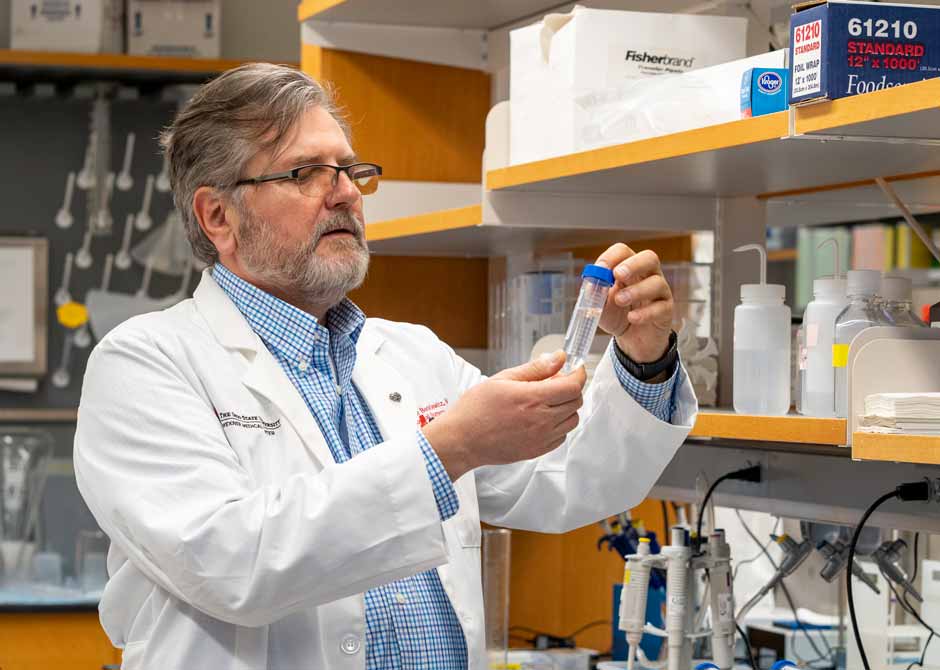
New Gene Therapy Institute positions Ohio State as a leader in translational science
 Three years ago, Krystof Bankiewicz, MD, PhD, a leading physician-scientist in translational gene therapy, was presented with a unique opportunity. His colleague, Russell Lonser, MD, professor and chair of Neurological Surgery at The Ohio State University College of Medicine, proposed a partnership, one with the potential to change the trajectory of gene therapy science.
Three years ago, Krystof Bankiewicz, MD, PhD, a leading physician-scientist in translational gene therapy, was presented with a unique opportunity. His colleague, Russell Lonser, MD, professor and chair of Neurological Surgery at The Ohio State University College of Medicine, proposed a partnership, one with the potential to change the trajectory of gene therapy science.
Dr. Bankiewicz is renowned for his development of translational approaches to drug, gene and cell replacement therapies. He pioneered delivery of gene therapeutics directly to the brain to treat neurological disorders, such as Parkinson’s disease, Alzheimer’s disease, Huntington’s disease, pediatric neurotransmitter deficiency and lysosomal storage disorders.
Dr. Lonser laid out his case for Dr. Bankiewicz joining his team to accomplish the college’s goal of pioneering foundational, translational and clinical gene therapy platforms. To accomplish rapid clinical advancements, they would need to foster a unique, collaborative environment between academia and industry. Ohio State offered one of the best environments to do this. Dr. Bankiewicz seized the opportunity.
“We knew from experience that the successful translation of gene therapy science is a complex process spanning research, product development and production, quality control, clinical trials, regulatory assessment and public-private collaborations,” Dr. Lonser says. “Our work alongside industry partners, including Battelle, Medtronic, Biogen and Bayer, enabled us to swiftly advance existing science.”
Drs. Bankiewicz and Lonser developed a technique where they monitor the direct infusion of genetic material into the brain using real-time MRI imaging so they can perfectly target an area to affect a cure. The brain then integrates the new functioning gene into its circuitry, which is composed of a cluster of neurons. These neurons receive electrochemical information that the circuit then modifies and transmits to other circuits in the brain that need this modified genetic material to function properly.
Ohio State holds one of the largest first-in-human clinical trial portfolios in gene therapy and is one of the only institutions with most of its gene therapy trials delivering targeted gene therapy to the midbrain.
“We have 10 active trials, grant support of $14.6 million for a first-in-human nervous system gene therapy trial and $4.8 million for translational CRISPR gene therapy research from the National Institutes of Health,” says Dr. Bankiewicz, who now serves as professor of Neurological Surgery at the Ohio State College of Medicine.
Together, Drs. Bankiewicz and Lonser co-lead Ohio State’s Gene Therapy Institute, a groundbreaking initiative to centralize gene therapy research being conducted by more than 50 Ohio State faculty across the colleges of Medicine, Arts and Sciences, Law, Business, Veterinary Medicine, Engineering and Pharmacy.
Peter Mohler, PhD, vice president of Research at The Ohio State University and chief scientific officer at the Ohio State Wexner Medical Center, says this new institute will be a model for how collaboration can solve some of medicine’s most pressing challenges.
“Bringing together our experts from a broad range of disciplines will lead directly to new, life-changing treatments for patients as well as new discoveries in fundamental biology,” Dr. Mohler says.
The results have been nothing short of a miracle. Especially for pediatric patients with an extremely rare genetic condition known as AADC deficiency. These children lack an enzyme that produces dopamine in the central nervous system, leaving them unable to control their muscles, speak or hold up their heads.
This new gene therapy has enabled patients to learn to walk and parents to hear their children’s voices for the first time.
“The chance to be able to get kids somehow restored, that really has made a huge, huge impact on me,” Dr. Bankiewicz says. “It has been the most profound experience of my whole professional career.”
Dr. Lonser attributes their success to the leadership and culture at the university, which supports and prioritizes innovation and discovery. This built framework allows researchers to build on shared knowledge, redesign cells and organisms by engineering them to have new abilities and functions, and to apply these discoveries to disorders that afflict millions of people around the world.
“Both Dr. Bankiewicz and I have worked on both coasts throughout our careers, and I think what’s really been unique about Ohio State is that they have incredible leadership that can see the innovative pieces,” Dr. Lonser says. “Ohio State is positioned to become the world leader in gene therapy.”